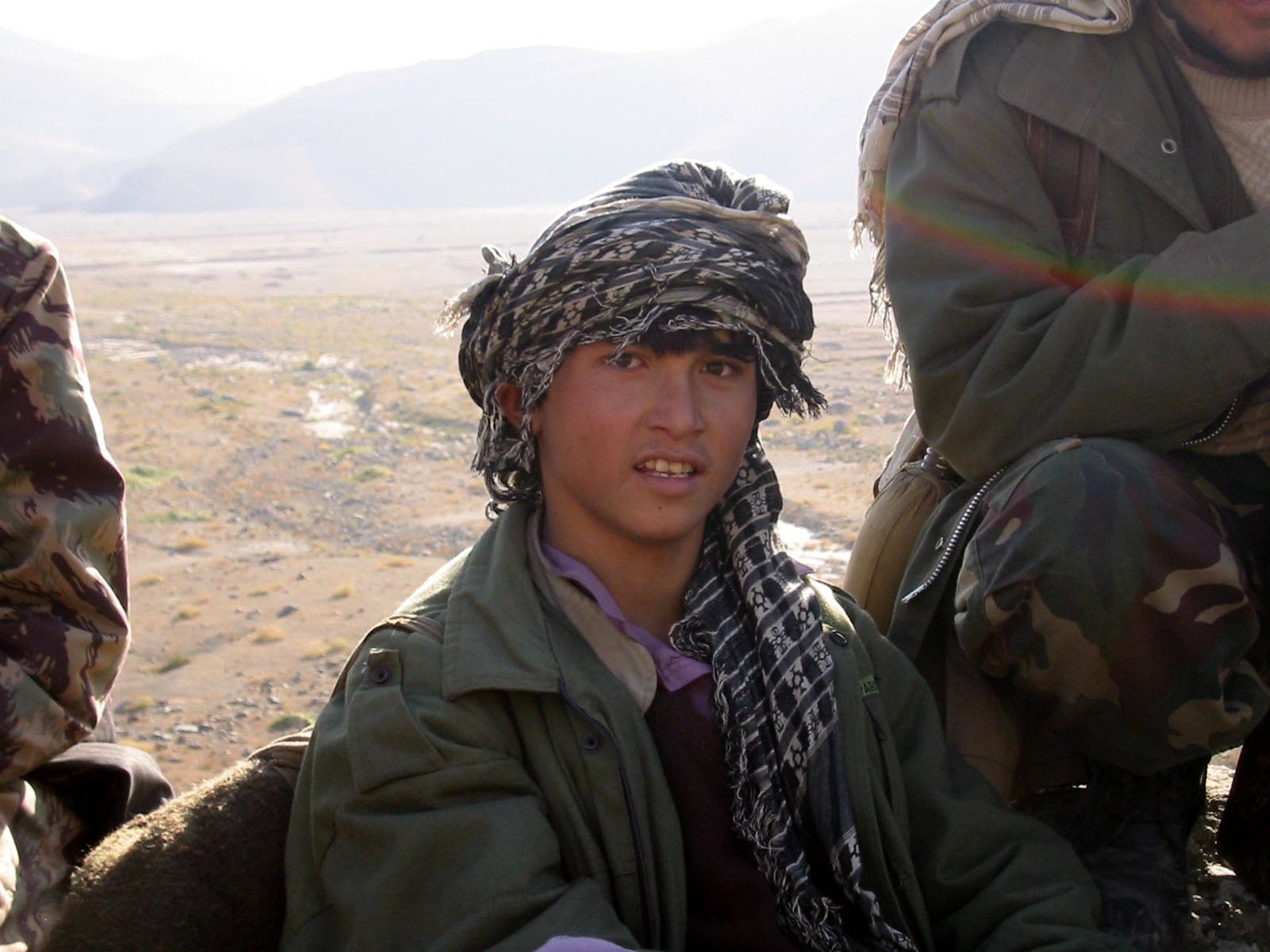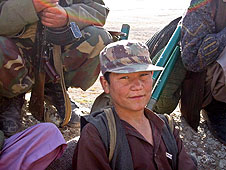
4 November, 2001, Afghanistan. Another boy traveling with Northern Alliance forces just before the Taliban retreated from Taloqan.
Photo: Phillip Robertson
Homayoun, the hotel manager, brought firewood for the stove and sleeping mats, while Abdullah took the opportunity to get stoned out of his mind. Homayoun had a light beard, blue eyes, and a very kind demeanor, like the one good kid in school. We sat on the floor with him and drank green tea with sugar as the room warmed up. He wanted to know if we wanted to drive around Ghazni with him as our guide, and we said sure.
In the car, he told Abdullah to drive up toward the walled city, and as we worked our way up the hills, the towers of Mahmoud Ghaznavi came into view, graceful 1,200-year-old brick structures named after a powerful 10th century ruler. They were set a considerable distance apart, possibly the better part of a kilometer, and Homayoun told Abdullah to pull the van close to one of the towers so we could get out and have a look around. In a shallow ravine behind us we saw the remains of a Taliban tank. It looked like they had hidden it there to escape the American bombing raids. A short distance down the hill was a military storage site where more tanks and heavy artillery were kept, but these belonged to the new government and still worked.
On the way up in the van, I asked Homayoun what was going on
in Ghazni these days, what the big news was. "Nothing," he said. "Ghazni is completely at peace." Homayoun did not mention that less than two weeks before, Around Jan. 17, two brothers were murdered by bandits at the gas pump for small change. Homayoun heard the shots, because the pumps are right out in front of the hotel. He also forgot to mention that everyone in town knew who did it.
We walked around the tower. Its foundation was exposed, and it seemed like there should have been an entrance, but we couldn't find one. I was still looking when a very old man in a white turban came up from the fields to say hello. His teeth were stained from putting powdered Afghan tobacco in his mouth. The old man explained that the towers marked the boundaries of the precious- stone bazaar, and that they were joined by an underground tunnel. "But the government won't allow people to take the stones," the man said. I thought he meant that people weren't allowed to take bricks from the structures to use for their own houses. As we were talking, a group of child soldiers came up the hill toward us with their Kalashnikovs on their backs. The kids' clothes were dirty and none of them were wearing a pakul: They mostly wore white turbans, like the old man. A commander came up the hill with them. Everyone was relaxed, just having a visit. The commander introduced himself as Qasim, and said that he had worked as chief of police during the Najibullah government, and then he asked if I had seen the Buddhas on the opposite hill. I hadn't. Qasim then volunteered an interesting piece of information.
"The Taliban stole antiquities and brought them to Pakistan where they were sold. They stole everything, the historical things of Mahmoud Ghaznavi. Scientists from Pakistan came to examine the artifacts, then they were packed up and taken out of the country." If it was true, Pakistan was complicit in looting the history of Afghanistan. At Bamiyan, the Taliban destroyed 1,500-year-old standing Buddhas with explosives, but I hadn't heard of Afghan artifacts being sold or transferred to museums in Pakistan. I asked Qasim how he knew the artifacts were sold, and the question made him angry.
"We live here. We know what happened to those things." I wanted to go see the place where the artifacts were looted. Qasim said it would be OK, and offered two of his child soldiers as a security detail. We asked Qasim to come with us, but he wasn't interested.
The two fighters piled into the van, one in the front passenger seat, the other next to Aman, and they told Abdullah how to get to the monuments. We rolled slowly down the hill into a dry riverbed, past a cluster of abandoned buildings.
There was a sharp crack that I thought was a blown tire. Aman looked at me and said, "They are shooting at us." It was impossible to see who they were or where the shots were coming from. Abdullah hit the brakes, and one of Qasim's fighters opened the door and waved. The shooter came running toward us and climbed into the van with his gun, sharing the front seat with a Qasim fighter. Abdullah said, "We will all be killed." I told him, through Aman, to calm down and drive, and he did. We kept going down the riverbed toward the hills where the Buddhas were supposed to be.
A few minutes later, we came to a second set of houses set against the hills. It was not a checkpoint. There was no road. There was nothing to guard, no military equipment. These buildings were out in the middle of nowhere. When the fighters who lived there saw us coming, they ran out in force with their weapons raised. They were acting very strangely, like they were on the front end of a bad amphetamine binge. More child fighters came toward the van; there were 12 or 15 of them now. One kid had a machine gun mounted on a tripod that he tried to straighten out as he ran, his turban completely covering his face. Abdullah took one look at the scene and hit the brakes. Two of them reached us at about the same time, while the rest hung back covering the car with their Kalashnikovs. They were wild children, breathing hard after running down the hill.
 LEAD IMAGE: 4 November, 2001, Afghanistan. A rocket bearer with Northern Alliance forces. Many male children without a means of support are picked up by fighters who give them food and shelter. I believe that a great number of these children are abused by the older men in their units. None of these children could read or write.
LEAD IMAGE: 4 November, 2001, Afghanistan. A rocket bearer with Northern Alliance forces. Many male children without a means of support are picked up by fighters who give them food and shelter. I believe that a great number of these children are abused by the older men in their units. None of these children could read or write.Photo: Phillip Robertson.
© Phillip Robertson, 2009-2014.
